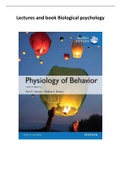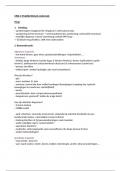College aantekeningen
Extensive notes of the lectures and book (12th edition) Biological psychology
- Vak
- Instelling
- Boek
This document contains extensive notes of the lectures and summaries of the subjects in the book that are not discussed during the lecture. A lot of pictures are included with explanations. Also the practice questions from the lectures are included with a clear explanation of the right answer. The ...
[Meer zien]





